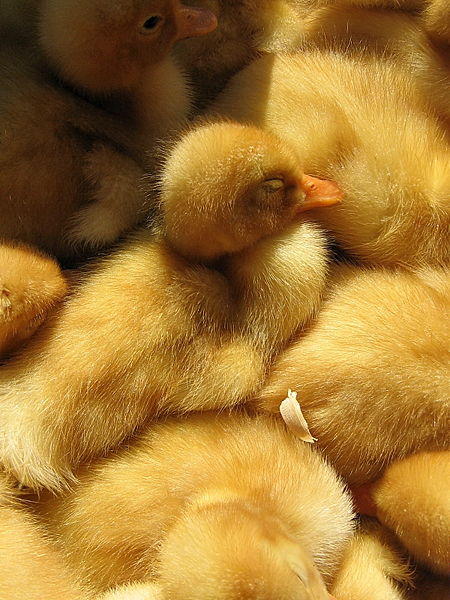
Source: Flickr / Navena / All Rights Reserved
A friend tells me the most important task for Science and the Sacred is to present evidence of evolution in ways people without a biology background can understand. A year ago, this friend thought all species on earth were created from scratch in six 24-hour days about 10,000 years ago. After reading books about biology, he now believes this is wrong. He told me most of the people he associates with have no idea just how solid the evidence really is, but once Christians understand what biology reveals about the creator’s work, we’ll be able to worship more meaningfully in spirit and truth.
If birds are ancestrally related to reptiles (as biologists believe), then birds’ ancestors had teeth. Not surprisingly, in fossils of transitional species from about 150 million years ago, teeth are present, as well as many other reptilian features. By about 80 million years ago, the species were considerably more birdlike, but still had teeth. Soon after that though, species without teeth became dominant; birds’ teeth had gone the way of electric typewriters and phonograph records.
If new species arise by gradual modification of pre-existing species (as biologist believe), we might expect that some of the raw equipment for old, out-of-date body parts might persist for a while, just as many homes today contain unused record players. There is thus reason to believe that birds might retain the ability to build teeth. Consider the following experiment: Scientists took a layer of cells from the mouth region of a developing mouse embryo and placed it into the mouth region of a developing chick embryo. Then, unbelievably, the beak of the chick embryo developed rudimentary teeth. The cells of the bird embryo, combined with specific cells from the mouse embryo, had made teeth! When examined in detail, biologists found that the bird embryo had the “instruction manual” for teeth already in place and needed only a “go” signal, which they got from the mouse cells.
Here is how this happened. Cells in the body use a chemical “language” to talk to each other. For example, there is a gene called Pax6 that is necessary for eye development in mammals. Even flies have a version of this gene. Pax6 makes a protein that serves as a chemical message. When produced by one set of cells, it “tells” another set of cells to “build an eye.” If you put the mouse Pax6 gene into the cells of a fly, the message is released and the fly cells understand the mouse’s chemical “language.” They start to build the only eye they know–that of a fly. Investigators have even installed the mouse Pax6 gene in a fly’s leg, and the leg cells respond to the mouse message by making a miniature fly eye in the middle of the leg. After hundreds of millions of years of evolution, the fly cells and mouse cells can still communicate with each other.
How did the cells in the developing beak of a chick embryo respond to oral mouse tissue and make teeth? Think about it. Fly cells can respond to a mouse signal and make eyes. Perhaps the mouse cells told the chick cells to “make teeth,” so they did, as best as they could. If so, perhaps bird evolution included a mutation that “shut down” the species’ own “make teeth” message. Could it be that, after 75 million years, the oral tissue of a developing bird can still understand the chemical phrase “make teeth” and respond accordingly? The evidence would say “yes.”
Those experiments were done three decades ago, but some new data have recently emerged, and it is now quite clear that rudimentary instructions for making teeth are still present in birds. In 2006, investigators described a single tiny mutation that affects chick development by causing embryos to make rudimentary teeth. How does a mutation result in the complicated process of tooth production? It does this apparently by causing a minor rearrangement of two tissue layers in the developing beak. In normal birds, these layers are too far apart for the responding layer to “hear” what the signaling layer has to say; hence, unlike in reptiles and mammals, the “make teeth” message isn’t transferred, and birds don’t make teeth. The simple instruction from the tiny mutation, however, brings the layers back together so that the responding layer can “hear” the chemical message once again. The responding cells didn’t make good teeth, but there is lots of evidence to show that making teeth is clearly what they were doing. Furthermore, when the investigators looked carefully at the production of these developing teeth, they found that they were being built in the way that reptiles, rather than mammals, build teeth; birds, according to evolution, came from reptiles, not from mammals, so this is exactly what we would expect to see if evolution is true. It is quite mysterious otherwise.
Let’s take this story further. I mentioned that the teeth are rudimentary. Several months ago, biologists analyzed the chick genome as it relates to the genes that other organisms use to build teeth. “Do these teeth-building genes still exist in birds?” they asked. Genes inhabit particular locations along a DNA molecule, and each gene has a neighbor on either side, just like the houses along a street. The genes live in “neighborhoods.” Various genes make the proteins found in tooth enamel, and we know where these genes and their neighbors reside in mammals. So we can look for enamel-making genes in this neighborhood of the chick genome. Guess what? Some of the genes are still there. They are now badly mutated like a house with broken windows and a roof in disrepair, but these enamel-making genes have been sitting unused in the genome for the past 80 million years. Since enamel genes are needed only to build teeth, mutations can persist in them because damage in an unused gene has no impact on survival.
If God built each bird species from scratch the way people who reject evolution think God did, why are the ancient genetic remnants of tooth production still present? On the other hand, if God works through natural processes, such remnants are exactly what one would expect.
Let’s stop and think about this. As we reflect on our own lives, has it not been primarily through natural processes that we have seen the activity of God? As you examine the God of the Bible, is this not often the story in biblical history as well?
Evolution is wonderfully consistent with the God of the Bible. We must conclude, of course, that there is some figurative language in the Scriptural accounts of creation, but the message of the Bible and the message of our lives parallel the message of science: God often works through natural circumstances. There is grandeur in this view of life.
Darrel Falk is a professor of biology at Point
Loma Nazarene University in San Diego and the executive director of The BioLogos Foundation.

